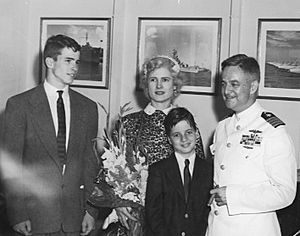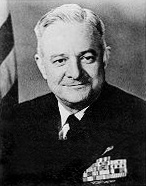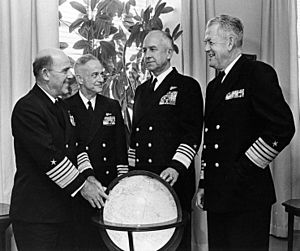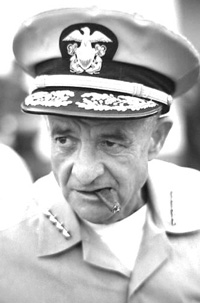John S. McCain Jr. facts for kids
Quick facts for kids
John S. McCain Jr.
|
|
|---|---|
 |
|
| Nickname(s) | Jack |
| Born | January 17, 1911 Council Bluffs, Iowa, U.S. |
| Died | March 22, 1981 (aged 70) Over the North Atlantic |
| Buried | |
| Allegiance | United States |
| Service/ |
United States Navy |
| Years of service | 1931–1972 |
| Rank | |
| Commands held | United States Pacific Command United States Naval Forces Europe Atlantic Reserve Fleet Eastern Sea Frontier Amphibious Forces, Atlantic Fleet USS Albany (CA-123) Submarine Squadron 6 USS Dentuda (SS-335) USS Gunnel (SS-253) |
| Battles/wars | World War II Korean War Vietnam War |
| Awards | Navy Distinguished Service Medal (2) Silver Star Legion of Merit (3) Bronze Star Medal |
| Spouse(s) | |
| Relations | John S. McCain Sr. (father) John S. McCain III (son) Joe McCain (son) Meghan McCain (granddaughter) |
John Sidney "Jack" McCain Jr. (born January 17, 1911 – died March 22, 1981) was a high-ranking United States Navy officer, known as an admiral. He served in major conflicts from the 1940s to the 1970s. One of his most important roles was leading the United States Pacific Command, which oversaw all U.S. forces in the Vietnam War.
Jack McCain came from a family with a long history of military service. His father, John S. McCain Sr., was also a famous admiral. Together, they were the first father-son duo to both reach the rank of four-star admiral in the U.S. Navy. His son, John S. McCain III, became a naval pilot, a prisoner of war, and later a well-known U.S. Senator.
Contents
John Sidney McCain Jr. was born in Council Bluffs, Iowa, on January 17, 1911. His family called him "Jack." Because his father was a naval officer, Jack grew up moving to different naval bases. He later attended schools in Northwest, Washington, D.C..
In 1927, at age 16, McCain joined the United States Naval Academy. He found the rules and traditions at Annapolis challenging. He often got into trouble and had average grades. He graduated in 1931, ranking 423rd out of 441 students.
After graduation, he became an ensign and served on the battleship Oklahoma. He wanted to become a pilot but was not accepted due to a heart condition. Instead, he joined Submarine School in Connecticut.
Family Life and Early Career
While serving on the Oklahoma, McCain met Roberta Wright. Her father was a successful businessman. They eloped to Tijuana, Mexico, and got married on January 21, 1933. McCain was briefly suspended for leaving his ship without permission.
Jack and Roberta had three children: Jean Alexandra "Sandy" (born 1934), John Sidney McCain III (born 1936), and Joseph Pinckney II (born 1942). The family moved often as McCain's naval career took them to different places, including Pearl Harbor, Hawaii. Roberta took on the main role of raising their children.
From 1938 to 1940, McCain taught electrical engineering at the Naval Academy. In 1941, he took command of his first submarine, the USS O-8, which was used for training.
Serving in World War II
After the 1941 attack on Pearl Harbor, McCain was often away from his family for long periods. As a lieutenant commander, he was given command of the submarine Gunnel in 1942.
Submarine Missions and Successes
Gunnel was first sent to North Africa in November 1942 as part of Operation Torch. The conditions were difficult, and the mission did not achieve its goals. The submarine also had engine problems.
After repairs, Gunnel moved to the Pacific Fleet. In June 1943, McCain's submarine patrolled the East China Sea and Yellow Sea. On June 15, he sank the Japanese freighter Koyo Maru. A few days later, he attacked a Japanese convoy. He sank another freighter, Tokiwa Maru, and hit a smaller ship.
The Japanese ships fought back, dropping depth charges that damaged Gunnel. McCain's crew spent many hours underwater. When they surfaced, the Japanese ships were gone, and they escaped. This patrol, though short, was very successful.
For his bravery and skill during this patrol, McCain received the Silver Star. His aggressive and adaptable style was well-suited for wartime submarine command.

In December 1943, Gunnel returned to action near Iwo Jima. McCain tried to torpedo a Japanese aircraft carrier but missed. He did sink another ship during this patrol.
In March 1944, off the Philippines, McCain again tried to attack a Japanese carrier but missed. He continued to patrol, but without further successful attacks on large ships.
In October 1944, McCain, now a commander, took command of the new submarine Dentuda. During his patrol with this submarine, he damaged a large freighter and sank two smaller patrol boats in the East China Sea and Taiwan Straits. For this, he earned the Bronze Star Medal with a Combat V device for valor.
At the end of the war, McCain sailed Dentuda into Tokyo Bay. He had one last meeting with his father, Admiral John S. McCain Sr., who had commanded a major carrier task force. His father passed away just four days after the Japanese surrender ceremony.
Becoming "Mr. Seapower"
After World War II, McCain stayed in the Navy. His family settled in Northern Virginia. He held various leadership roles, including Director of Records for the Navy and commander of a submarine division.
From 1950 to 1953, he worked on undersea warfare research. He also commanded several ships, including the heavy cruiser Saint Paul during the early Korean War. He later commanded the attack transport Monrovia and the heavy cruiser Albany.
Rising Through the Ranks
In November 1958, McCain was promoted to rear admiral. He worked in the Navy's Legislative Affairs Office in Washington, D.C.. Here, he built strong connections with important politicians. His home became a popular meeting place for senators and generals. He was very good at convincing Congress to support the Navy's budget, especially for building new aircraft carriers.
From 1960 to 1962, McCain commanded amphibious groups in the Atlantic. He became Chief of Naval Information from 1962 to 1963, dealing with the press. In July 1963, he was promoted to vice admiral and led all Amphibious Forces in the Atlantic Fleet. He helped plan "Operation Sea Orbit," a trip around the world by nuclear-powered Navy ships without refueling.
In 1964, McCain led "Operation Steel Pike," the largest peacetime amphibious landing exercise, off the coast of Spain. He received a gold star in place of a Legion of Merit for this operation. He also became a strong public supporter of the United States Merchant Marine, which transports goods by sea.
In April 1965, McCain commanded Task Force 124 during the United States invasion of the Dominican Republic. His forces helped restore order until the civil unrest ended. He earned another Legion of Merit for this mission.
McCain was known for his short height, his strong personality, and his love for cigars. He was also famous for asking his wife Roberta and her identical twin sister Rowena apart. He would famously say, "That's their problem."
He strongly believed in having a powerful navy and was known as "Mr. Seapower." He often spoke about the importance of naval strength, especially during the Cold War when the Soviet Union was building up its navy. He warned that the growing number of Soviet submarines threatened the free use of the world's oceans.
Leading in the Vietnam War
In February 1967, McCain was promoted to full admiral and became Commander-in-Chief, U.S. Naval Forces, Europe, based in London. He received another gold star in place of a third Legion of Merit.
In October 1967, McCain's son, John S. McCain III, a naval pilot, was shot down over Hanoi and became a prisoner of war in North Vietnam. This news was widely reported because of Admiral McCain's high profile.
In April 1968, President Lyndon Johnson appointed McCain as Commander-in-Chief, Pacific Command (CINCPAC). This meant he commanded all U.S. forces in the Vietnam War theater from his base in Honolulu. He received the Navy Distinguished Service Medal for his previous work.
As CINCPAC, McCain strongly believed in the domino theory, which suggested that if one country fell to communism, others nearby would follow. He often gave passionate briefings about the threat of Communist Chinese influence, showing maps with red arrows spreading across Asia. He believed the Pacific Command's job was to confront communist powers and protect smaller nations.
When Richard Nixon became president in 1969, he started the policy of Vietnamization, which aimed to gradually transfer the war effort to South Vietnamese forces. McCain was optimistic about this plan, believing that North Vietnam was weakening.
Expanding the War into Cambodia
McCain played a key role in expanding U.S. involvement in Cambodia. In April 1970, he personally briefed President Nixon and Henry Kissinger. He warned that Lon Nol's government in Cambodia would collapse without action against North Vietnamese forces operating there. He argued that stopping these operations was crucial for the success of Vietnamization.
McCain's views helped convince Nixon to launch the Cambodian Incursion later that month. He also worked closely with Cambodian leader Lon Nol, even hosting him at his guesthouse in Honolulu after Lon Nol suffered a stroke. McCain pushed for more military aid and staff for the Cambodian government, calling it "my war."
McCain was also concerned about North Vietnamese forces in Laos. He supported Operation Lam Son 719 in 1971, where the South Vietnamese Army invaded southeastern Laos with U.S. support. However, this operation ended in failure.
Every Christmas, while he was CINCPAC, McCain visited American troops in South Vietnam near the DMZ. He would stand alone, looking north, to feel closer to his imprisoned son. During the bombing of North Vietnam in 1972, McCain issued the daily orders, knowing his son was in the Hanoi area.
In March 1972, McCain's time as CINCPAC ended. President Nixon praised the contributions of the three generations of McCains at the transfer ceremony. McCain received a gold star in place of his second Navy Distinguished Service Medal.
Retirement and Legacy
Admiral McCain retired from the Navy on November 1, 1972. There was no special ceremony because of the one held two months earlier in Hawaii.
In early 1973, after the Paris Peace Accords, his son, John, was released from captivity in North Vietnam and returned to the United States.
McCain continued to advise on military matters, even meeting with President Gerald Ford in 1975. He also advised Ronald Reagan before his presidential campaign. McCain spoke out against the Panama Canal Treaty, believing that giving control of the canal to Panama would harm U.S. security.
McCain passed away from a heart attack on March 22, 1981, while on a military plane returning from Europe. He was buried at Arlington National Cemetery.
Namesakes
The Navy ship USS John S. McCain (DDG-56) was named to honor both Admiral John S. McCain Jr. and his father. In 2018, the Navy also rededicated the ship to honor Senator John S. McCain III.
McCain's life was featured in his son John's 1999 book Faith of My Fathers. Actor Scott Glenn played him in the 2005 television movie based on the book.
His grandson, John S. "Jack" McCain IV, also graduated from the United States Naval Academy in 2009. He became a naval aviator, continuing the family tradition. John S. McCain IV has a son, John S. "Mac" McCain V.
Awards and Decorations
Admiral John S. McCain Jr. received many medals and honors for his service:
 |
|||
 |
|||
| Submarine Warfare insignia | ||
| Navy Distinguished Service Medal with one star |
Silver Star | Legion of Merit with two stars |
| Bronze Star with Combat "V" |
Navy Commendation Medal with Combat "V" |
China Service Medal |
| American Defense Service Medal with "FLEET" clasp |
American Campaign Medal | European-African-Middle Eastern Campaign Medal with one battle star |
| Asiatic-Pacific Campaign Medal with four battle stars |
World War II Victory Medal | Navy Occupation Service Medal with "ASIA" clasp |
| National Defense Service Medal with one star |
Korean Service Medal | Armed Forces Expeditionary Medal |
| Vietnam Service Medal with three stars |
Legion of Honor (Philippines) |
Order of National Security Merit, 1st Class (South Korea) |
| United Nations Korea Medal | Vietnam Campaign Medal | Korean War Service Medal |
| Submarine Combat Patrol insignia | ||
See also
 In Spanish: John S. McCain, Jr. para niños
In Spanish: John S. McCain, Jr. para niños





